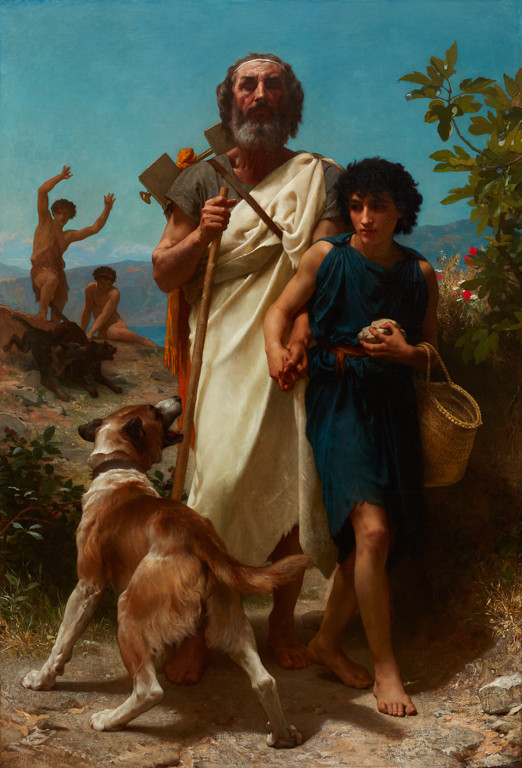 Primary Purpose: Use the painting Homer and His Guide by William Adolphe-Bouguereau to help students recognize and explore empathy and how artists can communicate emotions in figurative art with facial expression, body language, and visual storytelling
Primary Purpose: Use the painting Homer and His Guide by William Adolphe-Bouguereau to help students recognize and explore empathy and how artists can communicate emotions in figurative art with facial expression, body language, and visual storytelling
Background Information: Homer is the famous Greek poet and author of the Iliad and the Odyssey. This particular painting titled Homer and His Guide was painted by William-Adolphe Bouguereau in 1874. It depicts Homer, who is blind, being lead through uneven terrain by a worried shepherd boy ready to ward off the threatening dogs in the foreground and background. This painting was inspired by a poem written by French poet Andre Chenier about shepherds offering their help after hearing Homer pray for a guide.
Learning Objectives encourage students to:
• Describe, analyze, and read a work of art
• Use art vocabulary to describe artwork
• Tell a story about art based on visual information
• Discuss empathy by discovering the emotions and mood of a work of art
• Express their own feelings and personal connections with a work of art
Talking Points and Discussion Questions:
Ask students to simply look at the painting for a minute. It’s a life size painting, so there are many things to observe. All students should be encouraged to share an idea or thought in viewing the art. Questions should encourage students to investigate the image and find clues to support their ideas and interpretations. You can use any combination of these questions to help students understand this painting more deeply and make a personal connection to the work.
• What part of the painting did you notice first? (get several responses to demonstrate that people view art differently)
• Who are the people in the painting? How do you know that? (you decide if you would like to share information about Homer and what a shepherd is. Students might also comment on the relationship between the people with this question.)
• When does this painting take place? How can you tell?
• What is happening in this work of art? What kind of story does this work of art tell? (you may want to ask students to share their ideas with a partner first, so everyone gets a chance to express their thoughts. Many students will notice the dogs and boys in the background for this question.)
• Look at the faces and bodies of the people in this painting. How do you think they are feeling? How can you tell? (You may want to encourage students to make similar faces or pose their bodies in similar positions so they can better empathize with the figures in the painting.)
• Link to real life: What are some reasons people hold hands? Can you think of examples from your life? Why do you think the man and the boy in the painting are holding hands?
Classroom Helping Hands Art Activity 1:
- Ask students to trace a hand onto a piece of paper. They can pair up and work as partners or work individually.
- Ask students to write a list of things they need help doing around the hand they have traced. The list does not need to be straight or organized, the words and phrases the students think of can be written around the hand in any way. You may want to ask students for a few examples of what might be written in the space around the hand. (example: crossing the street)
- Next ask students to write a list of how they can be helpful to others inside the hand they traced. Again, you may want to ask students to give examples of what could be written inside the hand and this should help them think about how they can be helpful to others or how their hands can be used for helpful actions
- Direct students to share their work with others or use it to display acts of kindness around the classroom.
Classroom Helping Hands Art Activity 2:
Ask students to draw a picture that tells a story about themselves and someone special they hold hands with. They should consider who is in the picture with them and what kind of background can be added to help people understand the story of their relationship to one another.
Primary Purpose: This lesson will help students practice depicting people and creating a background to tell a story about the relationship between the people.
1. Look at Bouguereau’s painting Homer and His Guide with your students. What do they notice about the relationship between Homer and his shepherd guide? How can they tell? Draw attention to the hands and ask students to think/talk about who they hold hands with and why. Ask for volunteers to share their ideas with the group.
2. Use one of the examples given by the students and demonstrate how to draw the figures using simple shapes first.
3. Ask students to think of a person they would like to have in their picture with them holding hands, and using paper and pencil, allow the students to practice drawing the figures onto their paper.
4. For the next class, review an image of the painting, this time drawing student attention to the background and how it tells more of the story. Then go back to the example you demonstrated to them. Ask the students what kind of background would help tell the story.
5. Give some suggestions for what kinds of places they might choose or make a list with the students to help inspire ideas. Direct students to choose a place for their figures and begin drawing it in the background.
6. Next ask students to add more details such as specific clothing, hair, facial features, etc. to help communicate the identity of the figures.
7. Decide if you would like students to add color and what medium would be best for them to use.
8. When students finish, or if they finish early, they can write a story or poem to describe the figures in their artwork.
We would love to see examples of student work. Please email images/examples to teachers@mam.org.
